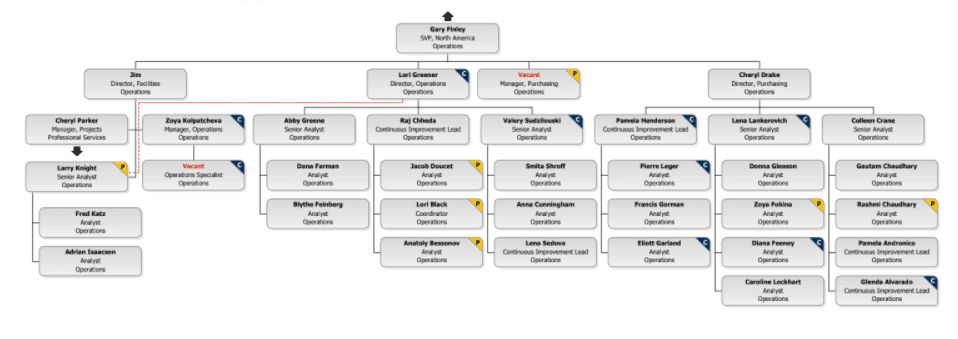June 28, 2023
2:41 PM
By OrgChart Team
An organizational chart, often called an org chart, serves as a visual representation of an organization’s structure. It depicts a company’s roles, responsibilities, and relationships, from top-level executives to lower-level employees.
Beyond mere representation, what is a primary function of an org chart? Its most fundamental roles are to improve efficiency, communication, and planning within an organization.
Efficiency is at the core of any well-functioning organization, and that’s where an org chart comes into play. Clear visualization of the organization’s structure enables a better understanding of how various roles and departments interact, thereby improving the workflow.
Communication is the lifeblood of an organization. A well-designed org chart can significantly enhance communication by clarifying the hierarchical structure and chain of command.

Org charts play a critical role in various organizational planning activities, from workforce planning to succession planning. The visual nature of org charts makes it easier to see where gaps might exist and how resources could be better allocated.
Let’s dive deeper into the use cases and benefits of accurate, automated org charts.
In the context of a reorg, merger, or acquisition, an org chart helps visualize the existing structure of the organizations involved, providing a clear picture of how various functions and roles might integrate or change.
Can an org chart show the complete picture? A good org chart can represent direct reporting relationships as well as the indirect or “dotted-line” relationships found in many modern organizations where shifting, cross-functional teams come together on long and short-term projects. Dotted-line relationships occur when an employee reports to a manager in another department for specific tasks or projects alongside their primary reporting relationship.

In matrix or project-based organizational structures, org charts are even more crucial. In a matrix structure, employees have dual reporting relationships — typically with a functional manager and a project manager. This arrangement allows for greater flexibility and better utilization of skills across departments.
However, it also comes with its complexities and potential for confusion. This is where an org chart steps in, offering a clear picture of these dual reporting relationships and ensuring everyone understands their roles, responsibilities, and whom they report to.
Similarly, in project-based structures where teams are dynamically created and disbanded based on project requirements, org charts can help keep track of shifting roles and responsibilities. They can clearly illustrate who is working on what project, under which project manager, and how they fit into the larger organizational structure. This transparency can significantly improve coordination and project management efficiency.
Workforce planning is another crucial HR task made easier with org charts. This process involves assessing current workforce capabilities, identifying future needs, and planning how to bridge gaps.
Traditionally, creating and maintaining org charts was a manual process requiring significant time and effort. However, the process has become significantly more manageable and efficient with HR automation and org chart software. This automation saves time, improves accuracy, and allows for real-time updates, contributing significantly to HR efficiency.

Succession planning is a crucial strategic process that ensures a company’s continued operation by identifying potential successors for key positions. This task can be challenging without a clear visual representation of the company’s structure. With real-time updates and easy visualization of relationships, an automated org chart can be an invaluable tool for effective succession planning.
Understanding the role of org charts is crucial in the modern business landscape. With their ability to illustrate organizational structure, improve communication, and enhance planning, org charts serve as vital tools in the corporate toolkit.
Leveraging automated org chart software can dramatically improve HR efficiency by ensuring accurate, real-time representation of the organization’s structure, allowing for more strategic decision‑making.
From streamlining daily operations to assisting in significant changes like mergers, acquisitions, or reorganizations, org charts are indispensable. Their potential in illustrating complex dotted-line relationships and aiding in workforce planning and visualization cannot be understated. For project-based or matrix organizational structures, org charts can ensure clear delineation of roles and responsibilities, enabling efficient coordination and project management.
With all these benefits, org chart software is an investment that can significantly enhance HR efficiency and overall organizational effectiveness. Ready to experience these benefits firsthand? Request a demo of our org chart software today and unlock the full potential of your organization.